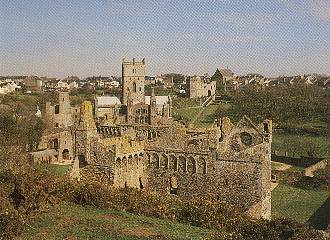 |
 |

St. David's Cathedral & Bishop's Palace
[Thursday - 05/06/99] Driving west towards the incredible Pembrokeshire coast of Wales, we simply had to stop at St. David's Cathedral. For centuries, it remained one of the most important and most visited sacred places in the whole of the British Isles. Even William the Conqueror, came here to worship! The shrine of St. David also attracted Geraldus Cambrensis, who sought the bishopric and who made three unsuccessful appeals to Rome to get it; Bishop Houghton, Lord Chancellor to King Edward III who earned his fame by being excommunicated by the Pope whom he in turn excommunicated from the Cathedral steps; Henry II, who prayed there for victory on his way to Ireland and who returned to give thanks for his successes; Bishop Ferrar, who was burned at the stake during the reign of Mary; and Bishop Davies, who procured the first Welsh translation of the Bible.
The Cathedral building sits in a hollow (Glyn Rhosyn) through which runs the river Alun. It is believed that the placing of the Cathedral was to hide it from Viking raids, as it cannot be seen from the sea. The Religious settlement, however, dates back much farther than the time of the Norsemen. In 55 AD, David is said to have transferred his monastery from Whitesand Bay to the little valley of the Alun.
In 1088, despite the secluded, half-hidden situation, the little settlement was sacked by Vikings raiding up and down the Welsh coast. In later years, the Cathedral also suffered grievous damage from earthquakes. Because of these events, no traces remain from the early founding, with much of the present church dating back only to 1180. Bishop Gower (1328-1342), the remains of whose magnificent palace can be visited on the Cathedral grounds, added much to the church.
During the English Civil War, Cromwell's troops were busily destroyed much of the Cathedral and its contents, and it was necessary for rebuilding programs undertaken by John Nash, in the late eighteenth century, and by Sir Gilbert Scott, in the nineteenth. Neither architect was able to do much about the slope in the floor which rises l4 feet from the West door up to the high altar (local legend says the slope was deliberately planned to get the congregation nearer to Heaven). The entrance to the Cathedral is through an impressive, ruined gateway and down a steep flight of stone steps known locally as the 39 Articles.
The Cathedral contains the shrines of St. Caradog and St. Justinian as well as St. David (though the latter may not actually be buried there according to recent scientific tests of the bones). It also houses one of the only surviving medieval Bishop's thrones in Britain. Edmund Tudor, father of Henry VII is also commemorated here by an impressive altar-tomb. The remains of Bishop Gower's opulent Palace was built in l340-- two hundred years later, another bishop had the lead from the roof slowly stripped away to provide dowries for his five daughters --all of whom married later bishops!
|
Last modified on Wednesday, November 26, 2008 URL: http://www.housecorvus.org/std.htm Copyright © 1999, 2000-09 House Corvus. All rights reserved. Design and hosting by Bran Trefonnen. | |